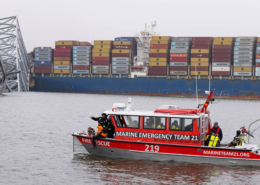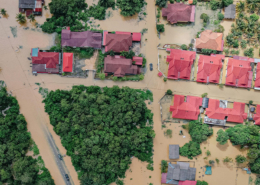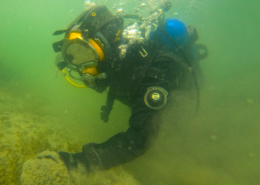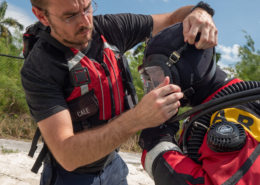Follow Up: How to Move from a Recreation to a Public Safety Dive Team
By: Tanya Chapman
In an earlier post, the story of one person’s journey into scuba diving through becoming a SDI/ERDI instructor faced with managing a public safety dive team with a large metropolitan department was shared. In that story, the author related personal experiences encountered while joining a team which operationally were functioning utilizing recreational training and guidelines. In the shared story the author was able to introduce and establish the use of ERDI principles to this team which accepted an implemented them as standard operating guidelines. The story represents how the incorporation of ERDI principles may be successful for public safety dive teams.
Mentioned in this article, was the utilization of a training agency focused on providing law enforcement training which the author attended during his introduction to ERDI training, as well as, his commanders initial certification course. Having been involved with both of these training courses in addition to training provided to this agency prior to the adoption of ERDI provides a unique perspective to address the question of what public safety training is all about.
It was not uncommon for an agency head to query its members if any were certified scuba divers
During my tenure working for a state sponsored training facility I have observed varying degrees of training and proficiency demonstrated by public safety agencies. Years ago, in smaller agencies it was not uncommon for an agency head to query its members if any were certified scuba divers in the event of an accident involving submersion or the attempted concealment of evidence underwater. If anyone responded in the affirmative, they were then asked to respond with their personally owned scuba equipment to the dive site. The diver(s) planned their dive based on the circumstances encountered upon arrival at the scene, entered the water, completed the dive, surfaced, exited the water and left the scene. Typically, the safety considerations of the divers was coordinated and addressed by the divers themselves. Rarely was there support on scene for the divers. Tenders were non-existent, standardization of dive gear was by chance not planned and a recreational open water certification card was the minimum and sometimes the highest level of certification required to get into water.
In retrospect, this type of diving was fraught with unnecessary risks and perils for those undertaking it but it was the norm of the day. An air of understanding was present when a fellow diver shared his or her story of facing similar circumstances. The love of diving and the concept of being impervious to harm led many of us to experience these situations in our early dive career.
As time progressed, standards developed within other areas which eventually began to trickle into the diving world resulting in the diving evolution we now refer to as public safety diving. Realizing the risks associated with putting divers into the water as part of their job function led risk management specialists to question how to reduce the potential workers compensation claims possibly arising from this action. These, in conjunction, with the realization of the enormity of danger divers were placing themselves in resulted in need for training in this specialized area.
As a result of this need a new focus area on public safety diver training emerged.
In its infancy courses were delivered by law enforcement or fire department personnel who were recreational dive instructors. While these instructors exemplified the standards of the day the curriculum which most relied was one of their own creations as a unique specialty recognized by a Recreational Scuba Training Council agency.
My association with the previous author’s post began at this point as I facilitated a portion of the training his team received at this level. At the time the training was considered the accepted standard. As often the case, as time progressed new techniques and concepts were introduced and established as the standards were replaced.
Discussions began with a respected colleague and author in public safety diving about the feasibility of creating a working group to address the needs of the public safety diving community. A partnership was formed within our state to pursue a joint venture with OSHA in hopes of creating a standard of training and uniformity for public safety divers throughout our state. This resulted in the adoption of the SDI/TDI/ERDI programs as the accepted standard by our academy. Favorable circumstances allowed the full implementation and delivery of these courses allowing the opportunity for personnel across our state and in limited instances for out of state personnel to attend which the previous author and his team benefited from in 2007 and later offerings.
Teams evolved into self-reliant units
Numerous departmental personnel were able to take advantage of this program and in several instances, we were fortunate to witness the evolution of dive teams from their initial stages through their growth into fully operational and capable teams, some with their own certified instructors on staff utilizing surface supplied gear, ROV’s, underwater communications, and various other devices to ensure their safety and successful completion of each and every operation. Teams evolved into self-reliant units one of which was able to obtain a conviction for murder primarily based on their recovery and crime scene documentation of a weapon used in the commission of a crime and thrown into a river. ERDI courses were the basic training tenets each of these teams were exposed to and relied on when developing their internal programs.
The previous author related a scene in which his new dive team commander was asked by his chief after completing his assessment of the agency’s dive team training and equipment if the team met current OSHA and NFPA training standards. The team leader had to reply “No Sir.” As a result, the team was placed on an indefinite operational hold until the deficiencies were corrected.
Public safety diver training is about preventing any team from being placed in the above situation. The avoidance of training deficiencies and the selection of the proper equipment required for the environment and situation encountered; as well as, the appropriate level of training for all personnel to ensure their safety and competence to successfully complete each mission.


 Photo By: Defense Visual Information Distribution Service
Photo By: Defense Visual Information Distribution Service


 Y. ZIN
Y. ZIN


Zanechajte komentár
Chcete sa pripojiť k diskusii?Neváhajte prispieť!